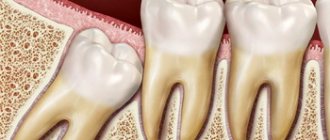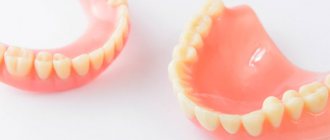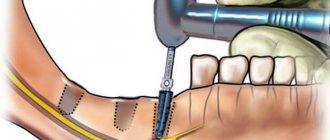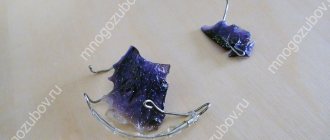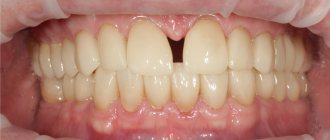Having installed braces in installments , at full price or on a promotional basis, the patient receives recommendations from the attending physician on how to care for them. Orthodontic treatment is accompanied by the need to especially carefully observe the rules of oral hygiene, as well as to stop eating a number of foods. A patient who does not follow these rules may experience braces coming off.
Metal, ceramic and sapphire braces are attached to the teeth using a special glue. Alignment of teeth and reduction of gaps between them is carried out using an orthodontic metal arch passing through braces and secured to the molars. Due to the tension arising in the system, the teeth gradually change their position, lining up in an even row.
| Metal braces When you decide to pay attention to your smile and make it perfect, you will be faced with the question: what method of bite correction should you use? Orthodontics has come a long way in recent years, and many new techniques and devices have appeared. But high-quality metal braces remain one of the most popular types of teeth straightening today. Specialists at the Moscow Smile Studio clinic often recommend metal braces to their patients, and there are explanations for this. | 99 900 ₽ Interest-free installments for 12 months! |
The stability of a tense brace system is highly dependent on increased pressure or sudden physical impact on its elements. If the glue used cannot withstand the additional load, the fixation of one, or less often several elements, may be broken.
Why do they put braces on teeth?
Installation of braces is a common method of orthodontic treatment. These structures help correct malocclusion, straighten teeth and help make your smile beautiful.
In this article
- Why do they put braces on teeth?
- How is a braces system installed?
- The bracket came off: what is the reason?
- What to do if the bracket comes off?
- The bracket has come off - what to do? Option 1
- Option 2
- Is it possible to reinstall a loose bracket?
- How does gluing happen?
- How long can you walk without braces?
- What to do if the last bracket comes off?
- Prevention of braces coming off
- Conclusion
Braces are small plates attached directly to the surface of the tooth, which are combined into a common system with a metal arch with shape memory. The orthodontist first calculates where the bracket should be placed on the tooth so that the displacement occurs in the right direction. And when the arch tries to return to its original shape, it puts pressure on the braces, and they, in turn, affect the teeth.
How to wear orthodontic traction bands - elastics?
Orthodontic rods - elastics - are special latex “rubber bands” that are placed on the hooks of the braces system to tighten the jaws together. They greatly increase the effectiveness of braces treatment. Properly selected and worn elastics do not interfere with speaking. The main rule of wearing pull-ups is regularity.
The time to start wearing elastics, their type and the pattern according to which the rods are put on the brace system is prescribed ONLY by the orthodontist. Wearing elastics on your own can only cause harm. Also, the orthodontist puts orthodontic rods on the patient’s brace system for the first time and teaches him to do it independently. In order not to forget the location of the rods, it is convenient to photograph the diagram and then carefully repeat it - it is not at all difficult.
How is a braces system installed?
First, based on X-rays and digital photographs, the orthodontist makes the necessary calculations and draws up a personal orthodontic treatment plan. Then, together with the patient, he selects a suitable brace system (metal, sapphire or plastic, external or internal). The next stage is preparation for the installation of braces, in particular the sanitation of the oral cavity. At this stage, it is necessary to cure caries and other diseases, replace old fillings with new ones, and, if necessary, separate or remove teeth that may interfere with the correct displacement of other units in the dentition. After sanitation, you can proceed directly to fixation. How is the bracket attached? There are two main installation methods - direct and indirect fixation. In the first case, plaque is removed from the enamel surface, etched, an adhesive base is prepared, the bracket is fixed using a composite material, and polymerization is carried out with light. With indirect fixation, braces are installed from a mouthguard previously made using photographs of the patient’s jaw. After preparing the enamel, the aligner with braces is fixed to the teeth and polymerized with light. The indirect fixation method is considered more accurate and takes half as much time as direct installation on each tooth separately.
After gluing the braces to the surface of each tooth, they are connected to each other using a metal arch. Attaching the arch to the braces can be done using the ligature method - using clasps and elastic bands. Or without ligation, when the arch is fixed with special clips.
General scheme of work
The procedure for fixing bracket systems is as follows:
- protecting tooth enamel from saliva;
- use of a special gel for etching enamel;
- washing it off using a water-air jet;
- air drying;
- applying primer;
- applying glue to the bracket mesh;
- polymerization.
The adhesive for braces hardens within 24 hours; during this period, the patient should avoid eating solid foods or foods containing dyes.
The bracket came off: what is the reason?
Sometimes a patient who wears an orthodontic device encounters such a problem that the bracket falls off. Let's look at the main reasons that can lead to such a situation.
- Inaccurate brushing of teeth.
The presence of braces in the mouth greatly complicates the process of oral hygiene. For careful and thorough dental care, a regular brush is not suitable, but several devices are needed at once - a brush with V-shaped bristles, a brush for cleaning teeth under the arch and an irrigator. If you use these devices carelessly or try to clean the braces with a regular brush, pressing hard on it, the plates may fall off.
- Poor hygiene.
The brace can come off not only due to too much activity, but also due to poor oral hygiene. In this case, cariogenic bacteria accumulate around the plate, plaque forms, which leads to the destruction of the enamel and the bracket coming off.
- Eating solid foods.
After installing the braces system, the dentist must provide nutritional recommendations. In particular, in order not to damage the orthodontic structure, it is recommended to exclude nuts, crackers and other hard foods from the diet. Dentists also do not recommend overusing toffees and other products that stick to teeth. If the patient neglects these recommendations, the situation when another brace falls off will be repeated regularly.
- Features of fixation.
Braces are attached to the surface of the tooth with a special glue. It has such a composition that after the end of orthodontic treatment the structure can be removed without damaging the tooth enamel. Thus, this adhesive composition, although quite durable, is not able to withstand every load. As part of the design, each bracket is pressed to one degree or another by a power arc, which thus “pulls” the teeth along with it. If a person has crowded teeth or a severe malocclusion, the pressure on different braces will be uneven. Due to this load distribution, some plates may come off. Most often this happens in the first days and weeks after installing the braces system.
- Unprofessional approach.
Some dentists use filling material instead of a special adhesive to glue braces. This method of attachment is less reliable, and braces fall off more often. There are also doctors who, when attaching plates, do not take into account the individual anatomical features of the patient, and the bracket can come off simply when the teeth are closed.
Thus, the reasons for the unsticking of the braces can be the actions of both the patient himself and the orthodontist. In both cases, the main question is what to do if the bracket falls off?
What type of adhesive material is most often used by orthodontists?
Currently, Blu-Gloo braces adhesive from the American manufacturer Ormco is the most popular among orthodontists. It has a bluish tint, which later becomes colorless. This braces adhesive was originally developed for a specific system, namely Dimon-3, but it can also be used with metal systems.
The most important advantages of this option for patients will be:
- color contrast during installation and complete transparency upon completion;
- practicality and ease of use;
- similarity of the base to all modern composite materials;
- there is no need for light polymerization when using it;
- ease of removing residues after completing the system installation procedure;
- The glue ensures reliable adhesion of tooth enamel to the braces system.
As already noted, the bluish tint of the glue becomes transparent after installation; when the system is removed, the opposite picture is observed - under the influence of water and air, it becomes blue again, which allows the orthodontist to remove the remaining glue without any difficulties or complications.
What to do if the bracket comes off?
The most correct thing to do in such a situation is to immediately call the orthodontist and make an appointment, and not try to glue the braces into their original place yourself. When the plate is not attached to the tooth, it does not perform its main function - correcting the bite. But the worst thing is that the overall effectiveness of orthodontic treatment is impaired. As other teeth gradually shift, one remains in place. This violates the treatment plan precisely calculated by the dentist and can ruin the entire process of bite correction or increase the period of wearing the braces.
Unfortunately, it is not always possible to quickly see a doctor: sometimes a specialist has an appointment several days in advance or you are in another city. Is it worth removing braces at home or what is the right thing to do in this case? Your actions will depend on whether the bracket is held in the arch or not.
Is it possible to remove braces early?
Sometimes braces are removed faster than planned. This is due to the anatomical features of the jaw structure and accelerated biological processes in the human body. However, such cases are extremely rare.
As a rule, the question “Is it possible to remove braces ahead of time?” doctors answer negatively. The patient must put up with certain inconveniences and undergo full treatment. Otherwise, the teeth will return to their previous position, and time and money will be wasted. In addition, removing the brace system ahead of schedule can lead to disruption of the temporomandibular joint.
Previously, braces could only be removed under certain circumstances.
- Correcting the bite does not bring results, and surgical intervention is required.
- There is an urgent need to replace one system with another for some reason - for example, a breakdown or an allergy to the material.
- The doctor is unable to cope with the anomaly and is forced to redirect the client to another orthodontist.
Is it possible to remove braces temporarily if important public events are coming up? Theoretically this is acceptable, but from a practical point of view it is inappropriate. Firstly, after removal the structure becomes unsuitable for secondary use. You will have to purchase a new system and spend money on its installation. Secondly, after repeated fixation, the time required to correct the bite increases.
Future newlyweds are interested in the question of whether it is possible to remove braces for the wedding. You should take care of the problem in advance and opt for ceramic or sapphire devices or transparent silicone aligners. Then the design will not spoil the festive image.
The bracket has come off - what to do? Option 1
If it comes off, but is held in a metal arc, proceed as follows. Pull the bracket out of the archwire. To do this, on non-ligature models it is enough to unfasten the clasp; on ligature models, you need to remove the elastic bands (these are ligatures). This can be done using tweezers, a toothpick or nail scissors. The goal is for the rubber band to come off the bracket. If you can’t remove it carefully, you can cut it, and the orthodontist will then easily replace the damaged ligature with a new one. Be sure to keep the braces and give them to the doctor when you see him.
Installation procedure
How are braces attached? To begin with, the orthodontist installs a special expander in the patient’s mouth, which will provide access to all teeth in the jaw and will prevent salivary fluid from entering the tooth enamel. After this, he begins to gradually treat all units with a composition containing a large amount of fluorine and other useful additives.
After this, orthodontic locks and rings are attached, and the brackets are fixed. Here the orthodontist works with the help of an assistant who applies an adhesive composition to the teeth. Next, the brackets themselves are installed. At the same time, for the convenience of the master, all elements are numbered. This process is painless and does not require the use of anesthetics. Duration of work – no more than 2 hours.
After installing the last bracket, the orthodontist carefully trims the remains of the arch along the edges and bends its ends, this is necessary in order to avoid accidental injury to the mucous membrane, lips and tongue. Some cases involve the installation of additional rubber bands or rods, which increase the arc pressure and enhance the overall effect of the system.
previous post
Is it possible to get a vaccination after dental implantation?
next entry
Option 2
Do not try to remove a loose bracket if it is tightly held in a metal arch. In this case, the best option is to do nothing until you see a doctor. If you are afraid of losing the plate while eating or brushing your teeth, you can temporarily secure it with special orthodontic wax. It’s definitely not worth trying to forcibly tear the bracket away from the structure, because you can damage the entire device. In this case, it will need to be completely replaced, which will cost a lot of money and time.
If you can't remove it?
If for some reason you were unable to remove the loose bracket, you need to put aside independent attempts to correct the situation and wait to see a specialist.
It's no secret that a dangling element will cause you a lot of inconvenience while sleeping or eating. However, this problem can be solved.
How and why to fix it?
You can temporarily fix a particle of the device on the enamel using orthodontic wax. This remedy is capable, although not of correcting the entire current situation, but of eliminating the feeling of discomfort.
Note! Under no circumstances should such repairs be used to fix the staple element for the duration of the entire treatment.
Only a qualified specialist has the right to install a detached element or replace it.
Improper fixation of the bracket can lead to disruption of the system’s effect on the dentition. As a result, the correction will not lead to the expected result.
Design differences of Pilot braces, indications for use and terms of wearing.
Let's look at the device of Win lingual braces here.
At this address https://orto-info.ru/sistemyi-vyiravnivaniya-zubov/breketyi/po-tipu-materiala/keramicheskie/clarity.html see photos of Clarity Advanced braces.
Is it possible to reinstall a loose bracket?
Braces are not cheap. Therefore, when they come off, patients often ask doctors not to install a new plate, but to fix the one that has fallen off. The dentist can accommodate you if the braces are not damaged. But according to the standards of orthodontic treatment, this is not recommended. In particular, because such braces have already damaged the adhesive coating, which enhances adhesion to the glue, and they can fall off again.
How to fix it yourself
To do this, you can use special wax.
First, you need to use cotton swabs to dry the saliva from the area where you want to glue the braces. Next, break off a small piece of wax and warm it with your fingers, then roll it into a small ball.
Good to know: waxing will not fix your problem, but will simply relieve you of physical discomfort. Therefore, as soon as you have the opportunity, contact your dentist immediately.
The next step is to glue the bracket, pressing on the place of fixation so that the lock is well fixed on the tooth.
How does gluing happen?
As soon as possible, you should go to the dentist to install a new brace. Usually, this requires disassembling the structure, removing arches and ligatures, cleaning, drying the tooth, and repeating the fixation procedures from the very beginning. If only one bracket has fallen off, then re-gluing it will take about 10 minutes. Some dental clinics offer patients 3-4 discounted procedures per year. If braces come off more often, in most cases this is due to non-compliance with the doctor’s recommendations, and you will have to pay for more frequent re-adhesions.
Some patients, in order to save money, try to glue the plate themselves. This cannot be done for two reasons.
- You do not have a special adhesive composition that is suitable for braces and is safe for teeth.
- It is necessary to glue the bracket in the correct position; this is the only way the bite will be corrected. Only an orthodontist can cope with such a task.
Where to remove braces in Moscow and how much does it cost?
The removal of the system is carried out by the attending physician in the same clinic where it was installed, so the patient does not have to look for a dentist to carry out the procedure.
With turnkey treatment, there is no need to find out in the capital's centers how much it costs to remove braces, since the service is already included in the final price. In addition, the amount includes the costs of the device itself and its installation. If all stages of bite correction are paid separately, then the cost of removing the device is about 10,000 rubles.
After wearing braces, you will need to put in a lot of effort to maintain a beautiful smile. However, those who have patiently gone through the entire path of bite correction from braces to a retainer confirm that the end result justifies any difficulties of the process!
What to do if the last bracket comes off?
Any brace can come off, but most often patients complain that the bracket on the last tooth has come off. What is the reason? The distant teeth are chewing teeth, which is why they experience increased stress when eating. Therefore, it is easiest to rip off a bracket from a posterior chewing tooth. The procedure for gluing brackets on the outer teeth is no different from that described above. The only difference is that it is easier for the latter to jump off the arch, so it is advisable to immediately remove them and save them until a visit to the dentist.
Glue characteristics
In terms of its characteristics, glue for braces differs in many ways from traditional glue, in particular, its key parameters will be:
- Resistance to various external influences.
- High degree of reliability of fastening bracket systems.
- Ease of use and application.
- Availability in specialized stores.
- The absence of harmful components in its composition.
It comes complete with the design; without it, reliable fixation of the system on the patient’s teeth is not possible. But it should be remembered that you must use only the original product; only in this case can we talk about guaranteed and reliable fixation.
Prevention of braces coming off
In most cases, it is possible to prevent braces from coming off if you follow preventive measures, which include strictly following the doctor’s recommendations.
- Dieting.
In the first days after the installation of an orthodontic structure, it is advisable to eat only soft and liquid foods - cereals, smoothies, yoghurts, cottage cheese. It is at this time that the risk of peeling is highest, and following a diet will help prevent it. In the future, you can eat different foods, with the exception of hard, sticky, too small (they will get stuck in braces) and coloring.
- Control of bad habits.
The habit of chewing the tip of a pencil or biting your nails not only leads to chipped teeth, but can also lead to peeling.
- Take good care of your braces.
When cleaning, all movements with a brush or brush should be smooth and careful so as not to damage structural elements. If you use an irrigator, be sure to choose a model with an orthodontic attachment - it is specially designed for gentle cleaning of brace systems.
- Maintain good oral hygiene.
If you don't brush your teeth thoroughly enough near the braces, a carious process can begin, which not only leads to the plate coming off, but also requires mandatory treatment. If the doctor diagnoses caries, the system will have to be completely removed, the teeth treated, and then reinstalled. This can be avoided by regularly cleaning your teeth and mouth, following the hygiene recommendations given by your dentist.
Why do braces come off?
There are several reasons why the structure moves away from the tooth enamel:
- In the initial stages of treatment, this is due to crowding of organs and lack of space in the oral cavity. As the voltage increases, the structure peels off.
- If you move the toothbrush carelessly.
- Eating tough, hard and sticky foods.
- When you try to pull something out of a brace or from your teeth (for example, when food remains get stuck in structural elements).
- With a gradual change in the bite, the structure begins to contact the opposing units.
Application area
After the teeth have assumed the desired position and orientation relative to their axis, a full stage of retention should be completed. It is needed in order to record the result obtained, otherwise, after removing the braces, the dental arch will immediately begin to move in the original direction, and the teeth will return to their previous position. Retainers are worn until the bone tissue in the jaw fills all the vacated spaces and becomes dense enough to eliminate the possibility of the roots returning to the places where they were before.
Sometimes during the retention period, fixed structures are used at the first stage, and later they are replaced by removable ones.
In what cases may tooth bonding be necessary?
Despite the fact that high-quality dental cement or glue is used for prosthetics, even securely fixed dentures periodically fall out. It also happens that a healthy tooth breaks off, and you really want to put it back in place. Below we consider three main cases when gluing of dental units is necessary:
- tooth chipping;
- tooth crown falling off;
- prosthesis falling out.
Tooth chipped
If a tooth is susceptible to caries or other dental disease, it will deteriorate over time, and splinters are likely to occur. In this case, the tooth will most likely have to be removed. However, even a healthy tooth can crack. The cause may be a simple injury or injury received, for example, from a blow to the jaw or when trying to chew something hard.
Loss of crowns is not uncommon, and the reason for this may be:
- Food. Most often, crowns fall off due to eating hard or sticky foods.
- Secondary caries. Its development is possible if, before installing a crown, the tooth was not fully treated and poorly prepared for installation. As a result, bacteria and microbes continue to multiply under the crown.
- Bad habits. The crown can become loose and fall out in people who chew on a pencil or pen, crack nuts, or crack seeds.
- Allergic reaction. Very rare. Incompatibility of dental tissues with the materials used can be easily avoided by selecting the latter correctly.
The prosthesis fell out
Dentures on teeth also tend to fall out. This happens for a number of reasons:
- loss of the tooth on which the prosthesis was fixed;
- presence of a defect in the product;
- poor quality material from which the product is made;
- low-quality glue for fixation;
- improper care of the prosthesis;
- expiration of service life.
Is it possible to glue a chipped tooth?
The primary question that concerns people who are faced with the problem of a chipped tooth fragment is related to the possibility of gluing the fallen part back. Regardless of whether it was a healthy or diseased tooth, you should consult a doctor. You should not resort to self-medication and try to glue your teeth together on your own.
Disadvantages and advantages
The main advantage of removable retainers is that they are installed once. If you can forget to put on removable structures or deliberately not do this, as happens with children and teenagers, then with non-removable ones such options are excluded. Convenience is the main advantage of such retainers.
They are completely invisible, as they are attached to the inside of the teeth, facing the inside of the oral cavity. In addition, they affect diction much less than retention guards or plates. However, they also have their drawbacks. For example, they do not protect against micro-movements of teeth. Large cracks will not appear, but if the patient is very scrupulous in this matter, then preference should be given to a custom-made plate or mouth guard.
Fixed systems are limited in application: most orthodontists believe that they should be installed only on the lower jaw, and that it is better to choose other devices for the upper jaw. Another disadvantage is the risk that a piece may come off or the wire will break. It is good if the patient has a retention tray or plate ready by this time. Then this spare structure should be worn until the meeting with the doctor takes place.
Is it possible to walk with a broken brace?
Braces are a single and complex mechanism. When one component comes loose, the functionality of the entire bracket is impaired. Therefore, it is important to visit an orthodontist as soon as possible if damage occurs.
Important!
If you continue to walk around with the brace unstuck, even on one tooth, then all the efforts previously spent on correcting the bite and uneven teeth will be in vain. A broken structure is deprived of the necessary strength and directional pressure, becoming useless or even causing damage to the jaw.
